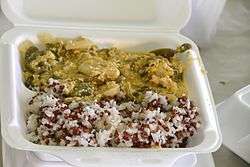Ema datshi
Ema datshi (Dzongkha: ཨེ་མ་དར་ཚིལ་; Wylie: e-ma dar-tshil[1]) is among the most famous dishes in Bhutanese cuisine, recognized as a national dish of Bhutan.[2] It is made from hot chili peppers and cheese; "ema" means "chili" and "datshi" means "cheese"[3] in the Dzongkha language of Bhutan.
 Ema datshi with rice | |
| Place of origin | Bhutan |
|---|---|
| Main ingredients | Cheese (cow or yak milk), chili peppers (green, red, or white) |
Different varieties of chilies may be used: green chili, red chili, and/or white chili (green chili washed in hot water and sun-dried),[4] which may be dried or fresh.[5] The chilies are called "sha ema" which is a Capsicum annuum,[6] and seems to be a form of pepper much like cayenne, poblano, ancho, or Anaheim.
The cheese in ema datshi is home-made from the curd of cow or yak's milk. In the process, the fat is removed from the curd to make butter, and the remaining curd without fat is used to make the cheese. After the cheese is made, a watery liquid is left over, which is used as a soup that can be taken with rice. No part of the curd is wasted.
Kewa datshi
A related dish is called kewa datshi which substitutes the chili for potatoes.[7][8]
A variant of ema datshi can be prepared. If the bean is substituted for chili, it is called bean (Semchum) datshi. If mushroom is substituted for chili, it is called mushroom (Shamu) datshi. Likewise any kind of dashi can be made using any vegetable or meat products. from meats one of the well known is beef datshi.
References
- "༈ རྫོང་ཁ་ཨིང་ལིཤ་ཤན་སྦྱར་ཚིག་མཛོད། ༼ཨ༽" [Dzongkha-English Dictionary: "A"]. Dzongkha-English Online Dictionary. Dzongkha Development Commission, Government of Bhutan. Archived from the original on 2011-08-25. Retrieved 2011-10-30.
- "BHUTAN: EMA DATSHI".
- Pandey, Geeta (2005-03-04). "Bhutan's love affair with chillies". BBC News. Retrieved 4 October 2011.
- Wangdi, Samten; Kencho, Yeshi. "Ema:The Fiery Bhutanese Food". Kuensel News Online. Archived from the original on 14 June 2012. Retrieved 4 October 2011.
- "A Brief Introduction to Bhutanese Food". Bhutanese Food Site. Retrieved 4 October 2011.
- "PACKAGE OF PRACTICES FOR CHILI PRODUCTION IN BHUTAN". Agriculture, Livestock & Forestry. Research & Development Center Bajo, Department of Agriculture, Ministry of Agriculture & Forests, Royal Govt of Bhutan. Archived from the original on 25 April 2012. Retrieved 4 October 2011.
- Kavita Kanan Chandra (30 December 2013). "Dragon Feast". Bhutan Observer.
- Andreas von Heßberg (29 June 2016). Bhutan: Unterwegs im Himalaya-Königreich. Trescher Verlag. p. 121. ISBN 978-3-89794-350-6.
Further reading
- Pommaret, Francoise (2006), Bhutan Himalayan Mountains Kingdom (5th edition), Odyssey Books and Guides, p. 296